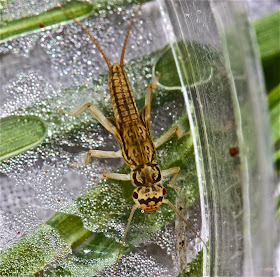Before I start writing this entry, let me call attention to two matters of interest to at least some of our readers.
1) A major study of
Isoperla Perlodid stoneflies has just been published, and it's available on line in .pdf format. The monograph is by S. W. Szczytko and B. C. Kondratieff and is entitled
A Review of the Eastern Nearctic Isoperlinae (Plecoptera: Perlodidae) with the description of twenty-two new species. To read and/or download this monograph, go to http://www2.pms-lj.si/illiesia/html/monographs_1.html, and click on download. This study focuses only on the adults: the nymphs will be covered in a separate issue.
2) For new or recent readers -- all of my photos are posted on Flickr. To view, go to https://www.flickr.com/photos/aquaticinsects_of_central_virginia/sets/, and choose the album "live photos only." I have recently added an album entitled "personal favorites" that you might also enjoy. Full size copies of all of the photos can be downloaded at this site. I trust you'll cite me if you use any photos.
__________________
The leafpacks in the Rapidan River are loaded at the moment -- literally "crawling" -- with two different taxa: the Perlodid stonefly,
Isoperla montana/kirchneri, and the pronggilled mayfly,
Paraleptophlebia sp. (which I'm quite sure is
mollis). One of my photos from Sunday is posted at the top of the page. And here are two more.
The gills on these nymphs, as you can see, are tracheated: the ratio is 1:3. That's very clear in this microscope shot.
That makes it likely that these nymphs are
Paraleptophlebia mollis (see Saturday's entry).
P. mollis and
P. adoptiva -- on which the gill ratio is 1:1 -- appear to be, from the reading I've done, the most common
Paraleptophlebias we see in the East.
When I was writing on Saturday, I assumed that the species we found was a matter of the type of stream in which we were looking. That isn't the case. As it turns out, each (
mollis and
adoptiva) has its season. On this matter, the consensus among fly fishermen has been that
P. adoptiva are in our streams first, hatching from March to May in the East:
P. mollis are found later on, hatching along with
P. guttata from June to August, i.e. throughout the summer. (For confirmation, see the emergence chart in Knopp and Cormier, p. 266, and the following website, http://www.troutnut.com/hatch/47/Mayfly-Paraleptophlebia-Blue-Quills/.
However, Donald Chandler has reached a different conclusion. In a note in Bugguide.net, Chandler states (speaking about New Hampshire): "
P. mollis is a winter active species, emerging in the spring and disappearing in late June, while
P. adoptiva is a summer active species first appearing here in late June." (http://bugguide.net/node/view/176301/bgimage )Being further south in Virginia, we might expect to see
P. mollis nymphs in late fall, with
P. adoptiva nymphs first showing up sometime in the spring.
Obviously, this is a these that can be tested, and at the moment I think that Chandler is probably right. It's mid-January, and at the Rapidan River I'm finding
P. mollis. As I've looked back through my photos, I find that the nymphs I've photographed in December in previous years -- in Sugar Hollow and South River in Greene County -- were
P. mollis as well.
12/12/12, South River
12/13/11, Sugar Hollow
Will I continue to find
only P. mollis this month and next month? Remains to be seen. And, will I see a changeover to
P. adoptiva in the spring? Remains to be seen. However, one of the photos I posted on Saturday was taken on 3/3/12 at South River -- it appears to have been
P. adoptiva (gill ratio of 1:1), suggesting that the change had already occurred.
________________
Now in all of this you will have noted that I've nicely side-stepped the issue of the "spines" on segment 9: neither
mollis nor
adoptiva are supposed to have them, but I can see them on both in the nymphs that I've found. This is a place where I have to read more, but from the photos I've seen that were taken by others -- and from all that I've read -- I find it hard to believe that our
Paraleptophlebias are
not adoptiva and
mollis.
Stay tuned! (Oh, fly fishermen. The Rapidan must have a
HUGE hatch of Blue Quills in late winter and spring, to say nothing of the Yellow Sallies (
Isopera montana/kirchneri) you're going to see!)














































